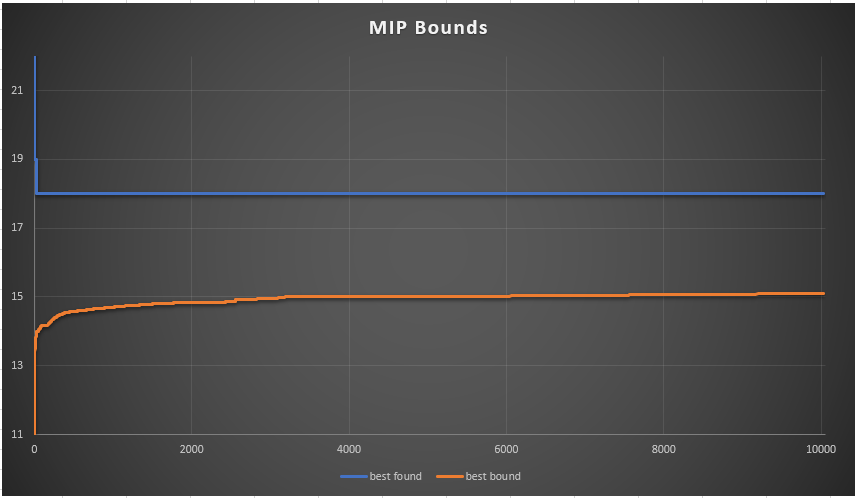| Transportation Problem |
|---|
| \[\begin{align}\min & \sum_{i,j} \color{DarkBlue} c_{i,j} \color{DarkRed} x_{i,j}\\ & \sum_j \color{DarkRed} x_{i,j} = \color{DarkBlue} {\mathit{supply}}_i\\ & \sum_i \color{DarkRed} x_{i,j} = \color{DarkBlue} {\mathit{demand}}_j \\ & \color{DarkRed} x_{i,j} \ge 0\end{align}\] |
We can solve very large instances very quickly. The fixed charge transportation problem is much more difficult:
| Fixed Charge Transportation Problem |
|---|
| \[\begin{align}\min & \sum_{i,j} \color{DarkBlue} c_{i,j} \color{DarkRed} x_{i,j} + \color{DarkBlue} d_{i,j} \color{DarkRed} y_{i,j}\\ & \sum_j \color{DarkRed} x_{i,j} = \color{DarkBlue} {\mathit{supply}}_i\\ & \sum_i \color{DarkRed} x_{i,j} = \color{DarkBlue}{\mathit{demand}}_j \\ & 0 \le \color{DarkRed} x_{i,j} \le \color{DarkBlue} M \color{DarkRed} y_{i,j}\\ & \color{DarkRed} y_{i,j} \in \{0,1\}\end{align}\] |
Here we have an additional cost \(d_{i,j}\) if link \(x_{i,j}\) is used (i.e. if \(x_{i,j}\gt 0\)). The binary variable \(y_{i,j}\) indicates if link \(i \rightarrow j\) is used. I.e. we want: \[y_{i,j} = 0 \Rightarrow x_{i,j}=0\] The constraint \(x_{i,j} \le M y_{i,j}\) is a big-M formulation for this. Notice that we do not need to worry about \(x_{i,j}=0 \Rightarrow y_{i,j}=0\): this will be taken care of automatically (because of the objective function). In practice we can do \[\begin{align} & x_{i,j} \le M_{i,j} y_{i,j}\\ & M_{i,j} = \min \{ \mathit{supply}_i, \mathit{demand}_j \}\end{align}\] This gives some reasonable values for \(M_{i,j}\). A problem with only fixed charge costs (i.e. \(c_{i,j}=0\)) is sometimes called a pure fixed charge transportation problem. If we just want to minimize the number of links that are being used we can set \(c_{i,j}=0\) and \(d_{i,j}=1\). These models can be incredibly difficult to solve to proven optimality.
Here we try to solve a very small problem with 10 source nodes and 10 destination nodes. I used random values for the supply and demand:
---- 20 PARAMETER supply src1 0.041, src2 0.203, src3 0.132, src4 0.072, src5 0.070, src6 0.054, src7 0.084 src8 0.206, src9 0.016, src10 0.120 ---- 20 PARAMETER demand dest1 0.178, dest2 0.103, dest3 0.177, dest4 0.136, dest5 0.023, dest6 0.114, dest7 0.028 dest8 0.045, dest9 0.119, dest10 0.078
The objective is \(\min \sum_{i,j} y_{i,j}\), i.e. we minimize the number of open links. This means we have just 100 binary variables. After setting a time limit of 9999 seconds I see:
. . .
5938307 5589691 15.7946 12
18.0000 15.0950 1.71e+08 16.14%
5946634 5596825 15.1040 25
18.0000 15.0950
1.72e+08 16.14%
5959435 5611506 15.1737 19
18.0000 15.0950
1.72e+08 16.14%
Elapsed time =
9977.59 sec. (3226694.74 ticks, tree = 38155.78 MB, solutions = 3)
Nodefile size =
36108.12 MB (23960.92 MB after compression)
5965049 5616397 16.0000 19
18.0000 15.0950
1.72e+08 16.14%
Cover cuts
applied: 264
Flow cuts
applied: 5
Mixed integer
rounding cuts applied: 331
Zero-half cuts
applied: 4
Multi commodity
flow cuts applied: 4
Root node
processing (before b&c):
Real time = 0.88 sec. (41.53 ticks)
Parallel b&c,
8 threads:
Real time = 10021.94 sec. (3248441.83 ticks)
Sync time (average) = 5484.02 sec.
Wait time (average) =
0.11 sec.
------------
Total
(root+branch&cut) = 10022.81 sec. (3248483.36 ticks)
MIP status(107):
time limit exceeded
Cplex Time:
10023.03sec (det. 3248483.36 ticks)
|
Ouch.. If you would have asked before, I certainly would have predicted somewhat better performance.
 |
| MIP bounds don't change anymore |
The best objective value of 18 was found after 25 seconds. We might as well have stopped at that point...
Most likely 18 is the optimal objective, but we have not proven that. The best solution looks like:
 |
| Best found solution |
No comments:
Post a Comment